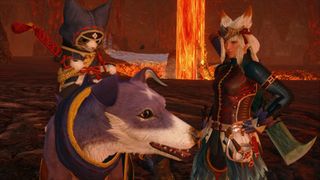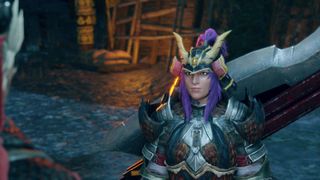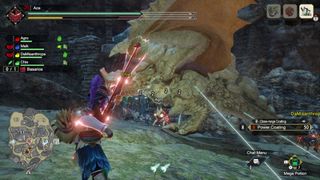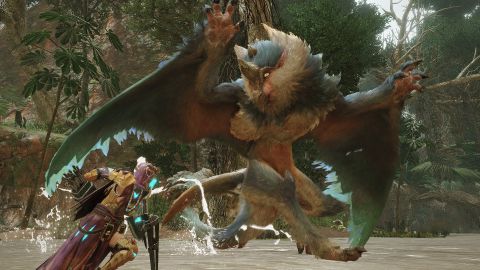Sometimes smaller really is better. After the highs of Monster Hunter: World’s astounding success, it’d be reasonable for Capcom to shoot for an even bigger, more complicated game. Instead, though, the Monster Hunter development team has opted for a smaller, more personal adventure, trading in World’s sprawling plains and snow-capped mountain ranges for a decidedly more low-key tale in Monster Hunter Rise.
As the titular monster hunter, the silent protagonist awakens to life in the small village of Kamura on the frontier, embarking on quests for the population to slay tyrannical beasts patrolling the wilderness. Monster Hunter Rise is a hack-and-slash action game at its core, but one with a graceful elegance through its 14 varied weapon types and devastating skill combos.
Tools of the trade

Monster Hunter Rise strikes an impressively delicate balance between gameplay styles. It’s pulling from World’s hefty numbers game and hidden mishmash of systems, and older Monster Hunter games' more arcade-like combat of hammering buttons. The result is something incredible: Rise feels fast and fluid, unshackling itself from many of World’s intricate design systems and feeling more open and inviting for newcomers who just want to slap a monster around.
Nowhere is the combat’s fresh pacing better embodied than the Wirebug. A small, unassuming tool, it quickly becomes apparent that the Wirebug has a crucial part to play in every aspect of Monster Hunter Rise’s gameplay. The tool can be used to propel the player into the air, grappling onto ledges to reach higher vantage points, and bringing an excellent sense of verticality to Rise’s biomes. It can even be used to evade a monster’s attacks, pulling the player from the literal jaws of defeat. In combat though, the Wirebug is used to initiate devastating moves, as simply pressing two buttons unleashes a powerful attack for any of the 14 different weapon types.
The Wirebug has different actions for every single weapon in Monster Hunter Rise. With the switch axe, for example, it’ll chain together a massive spin attack when used, whereas using it with the long sword propels the hunter up into the air, latching onto a monster and slashing downwards through it. The Wirebug is a brilliant addition to Rise, one that brings a crucial new gameplay element to every weapon, giving series veterans something new to learn and newcomers dependable attacks to learn from. The Wirebug uses are tied to a cooldown timer, so rather than becoming a fundamental of combat, it acts like a crutch to support the player when the going gets tough.

All of this is supported by a supple tutorial system. Rise starts out small, making sure the player knows every base combat mechanic and how to use each weapon, before delving into the more complicated territory of the Wirebug, blights, elements, and more. In 2018 it was incredibly easy to get overwhelmed by World’s vast systems and monsters right out of the gate, but Rise does a far better job of making sure rookie hunters and experienced slayers alike are acclimated to the inner workings of the game before turning you loose against deadly beasts.
The monsters themselves are an eclectic bunch. Series stalwarts like the fiery Anjanath and the poisonous Rathian return, joined by some utterly nightmare-inducing creatures like the ghastly Khezu. Every monster has something defining that you’ll remember them for: the Khezu can snake its slithery neck around the battlefield like a whip, and the Bishaten uses its claw-like tail to sling poisonous fruits at you. I’ll always have a reaction to seeing any of Rise’s brilliant cast out in the wild: it could be a “oh this guy” when a Rathian swoops down on me, or a harrowing scream when the Khezu roams into view. Every single one of Rise’s creatures are memorable in some fashion, no small feat when there’s well over 20 in the base game.
Fighting with friends

There’s not so much of a focus on co-op gameplay in the smaller monster hunts, but that changes the further you progress into Rise’s story. The game’s plot is divided into two paths of progression: village missions, which are designed to be smaller, lower level fights to be overcome by solo players, and bigger hub missions, which require a team of hunters working in close tandem with one another to best. The single-player village missions wrap up decidedly earlier than the co-op hub missions, forcing players down a path of working together with online companions to see the conclusion of Rise’s story. It’s a puzzling design choice - especially for the Nintendo Switch, a console that isn’t exactly known for its robust online infrastructure.
Still, Rise’s online features manage to work well within the confines of the Switch’s online capabilities. Approaching the feline mailman in Kamura Village lets the player search for a lobby of four hunters, or set up one of your own, giving you the option to invite friends in or group up with anyone. There’s mercifully very little busywork in getting going with Rise’s online features, and the quick-chat options being a button away and offering a litany of supportive shouts like “capture the monster” or “hold on!” feel catered to strangers working in greater harmony with one another to overcome ferocious hunting quests.

Outside of the hunting quests though, Rise introduces a new tower defense-like mode called Rampage. The outset of Rise’s story talks up Rampages as threatening Kamura Village and being the driving point of the story, and that all comes to a head in a fortified arena, where one or several hunters run around installing defenses like ballistas, cannons, and traps to repel the onslaught of monsters before the gates to Kamura Village are breached. The Rampages start off as the focal point of Rise’s story, but quickly find their groove as a way to break up the routine hunting quests.
The Rampages are pleasantly enjoyable in the moment but can become increasingly frustrating when you’re faced with monsters that bounce the hunter between them like a volleyball. Rampages further in the game starring elite monsters almost demand to be taken on by a squad of hunters, especially when the AI comrades you can place in ballistas and cannons barely make a dent in the hordes facing Kamura. Despite the frustrations though, Rampages are used sparingly throughout Monster Hunter Rise’s critical story path, offering something new to the standard hunts instead of being a backbone to support the core gameplay loop.
Monster Hunter Rise is a great debut for Capcom’s franchise on the Nintendo Switch, smartly providing sublime new tools to the established arsenal like the Wirebug, and acting as a welcoming point of entry for newcomers with overly welcoming tutorial segments. There’s a lot to like about the Rampage missions as a headline addition for the series, however harrowing they might become to face on your own in the latter half of the game. Monster Hunter Rise has the satisfying feeling of a smaller and more compact adventure than 2018’s sprawling World, but tying story progression to the game’s online co-op mode is a little disappointing.
Reviewed on Nintendo Switch. Code provided by the publisher.


